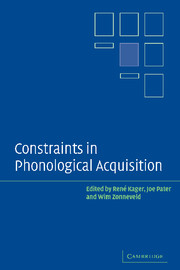Book contents
- Frontmatter
- Contents
- List of contributors
- Abbreviations
- Preface
- 1 Introduction: constraints in phonological acquisition
- 2 Saving the baby: making sure that old data survive new theories
- 3 Markedness and faithfulness constraints in child phonology
- 4 Input elaboration, head faithfulness, and evidence for representation in the acquisition of left-edge clusters in West Germanic
- 5 Phonological acquisition in Optimality Theory: the early stages
- 6 Syllable types in cross-linguistic and developmental grammars
- 7 Bridging the gap between receptive and productive development with minimally violable constraints
- 8 Learning phonotactic distributions
- 9 Emergence of Universal Grammar in foreign word adaptations
- 10 The initial and final states: theoretical implications and experimental explorations of Richness of the Base
- 11 Child word stress competence: an experimental approach
- Index of subjects
- Index of names
7 - Bridging the gap between receptive and productive development with minimally violable constraints
Published online by Cambridge University Press: 22 September 2009
- Frontmatter
- Contents
- List of contributors
- Abbreviations
- Preface
- 1 Introduction: constraints in phonological acquisition
- 2 Saving the baby: making sure that old data survive new theories
- 3 Markedness and faithfulness constraints in child phonology
- 4 Input elaboration, head faithfulness, and evidence for representation in the acquisition of left-edge clusters in West Germanic
- 5 Phonological acquisition in Optimality Theory: the early stages
- 6 Syllable types in cross-linguistic and developmental grammars
- 7 Bridging the gap between receptive and productive development with minimally violable constraints
- 8 Learning phonotactic distributions
- 9 Emergence of Universal Grammar in foreign word adaptations
- 10 The initial and final states: theoretical implications and experimental explorations of Richness of the Base
- 11 Child word stress competence: an experimental approach
- Index of subjects
- Index of names
Summary
Introduction
It is a commonplace observation that there are gaps between perception and production in child phonology; that children often appear to have receptively acquired a segmental or prosodic contrast that is neutralised in production (see section 2 below for a review of some evidence). The developmental lag of productive behind receptive ability raises a fundamental question: does perception or production reflect the state of phonological competence in the child's emerging linguistic system? The answer given in this chapter is that the child's knowledge of phonology is displayed in both domains, and that linguistic competence can be sufficiently variegated to handle gaps between their development.
Studies of phonological acquisition usually take children's productions as the data to be accounted for by phonological analysis, and studies of child phonology in Optimality Theory (OT) usually follow this tradition (see the Introduction to this volume for references to this literature; cf. Hale and Reiss 1998, Hayes this volume). However, there do exist data on the development of perception that appear to demand a phonological treatment. The experimental tasks used in recent research in infant speech perception tap not only phonetic discrimination but also the ability to store contrasts in memory, and to link these phonetic contrasts with meaning distinctions. This research suggests that the representations accessed in these tasks develop gradually, in ways quite parallel to the later growth in complexity of the structures employed in production.
- Type
- Chapter
- Information
- Constraints in Phonological Acquisition , pp. 219 - 244Publisher: Cambridge University PressPrint publication year: 2004
- 16
- Cited by



